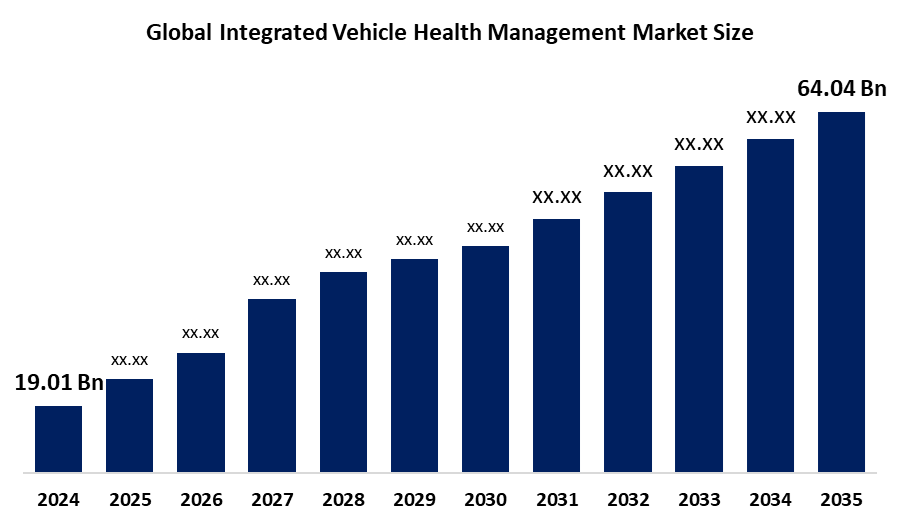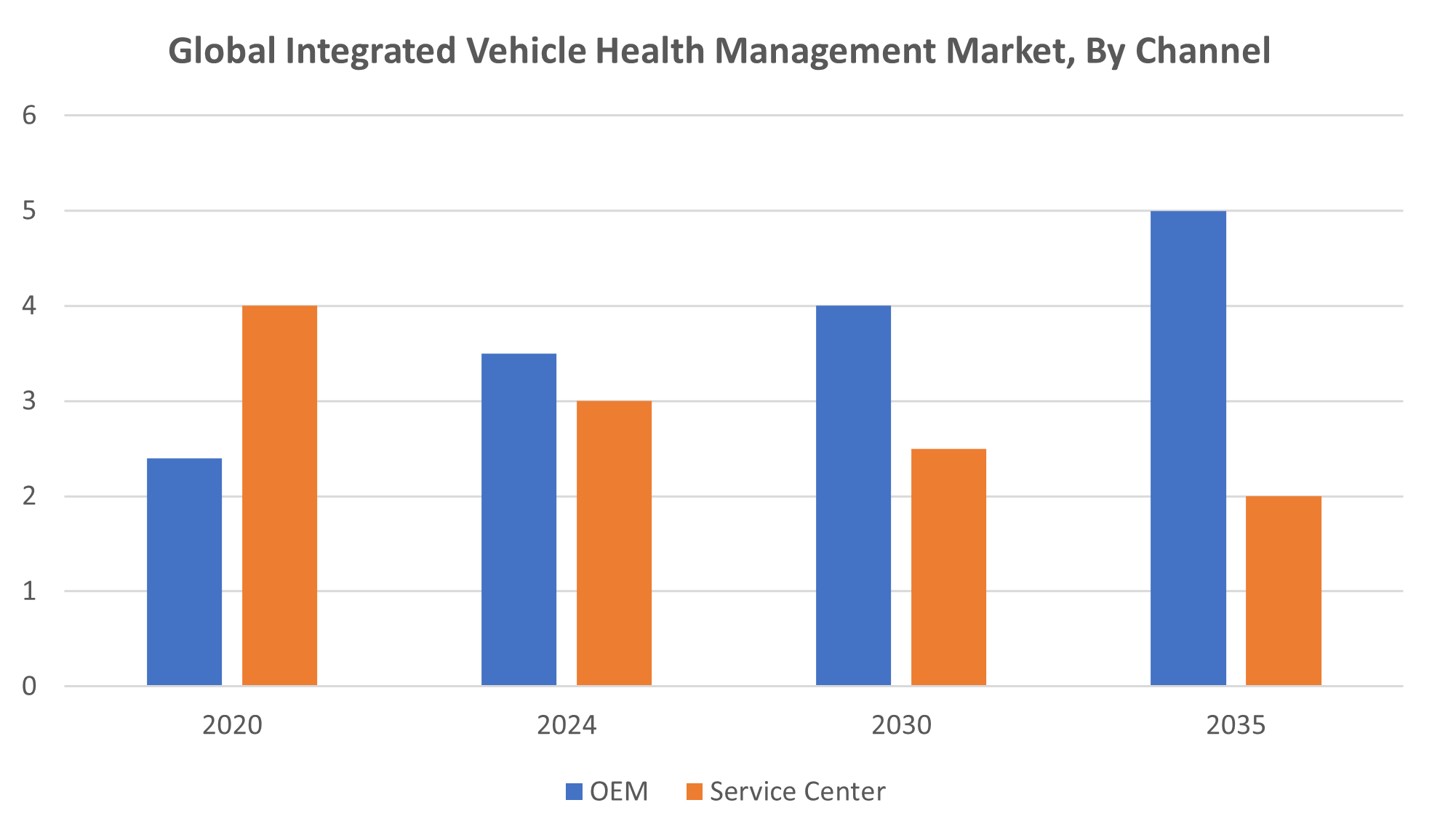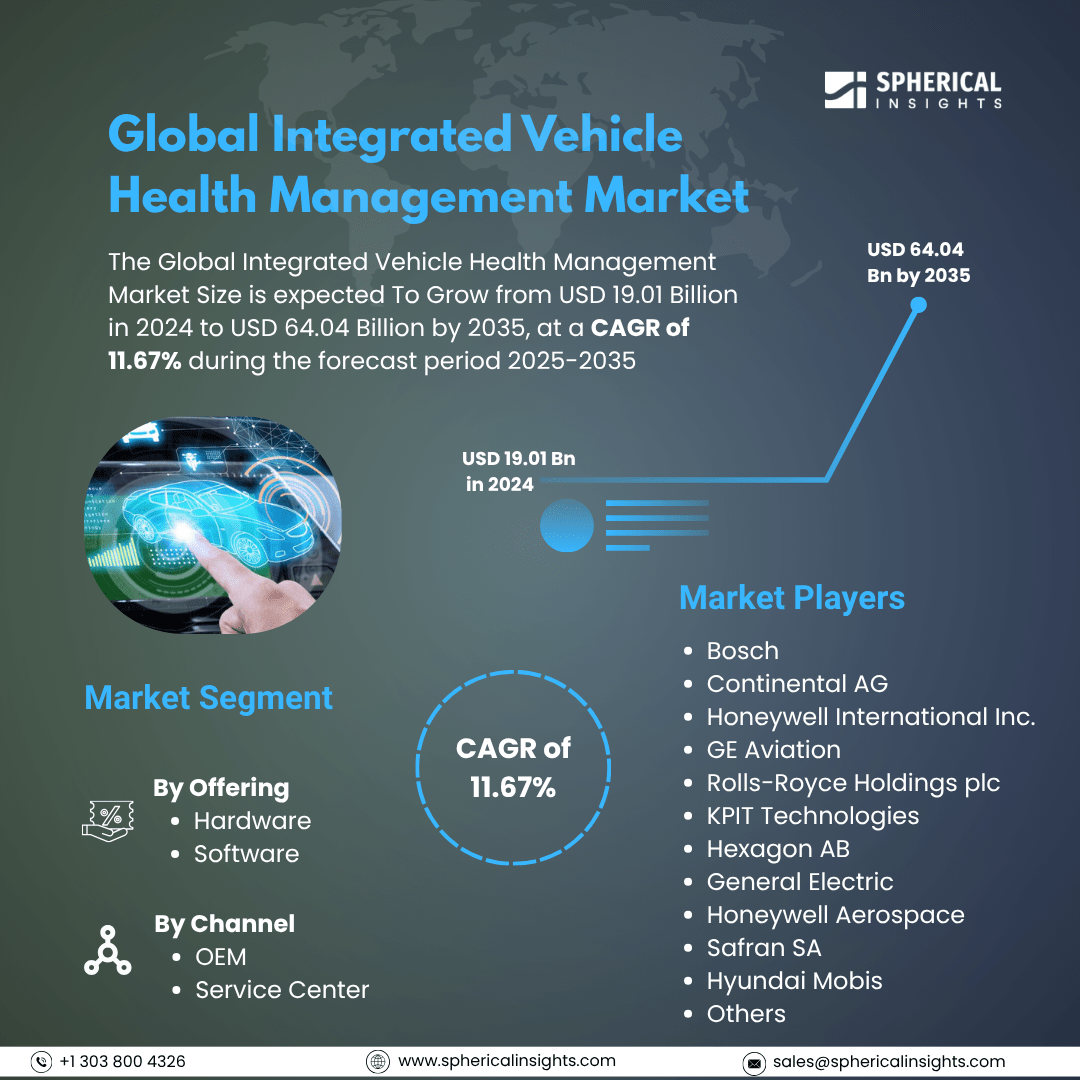Global Integrated Vehicle Health Management Market Insights Forecasts to 2035
- The Global Integrated Vehicle Health Management Market Size Was Estimated at USD 19.01 Billion in 2024
- The Market Size is Expected to Grow at a CAGR of around 11.67% from 2025 to 2035
- The Worldwide Integrated Vehicle Health Management Market Size is Expected to Reach USD 64.04 Billion by 2035
- Asia Pacific is expected to grow the fastest during the forecast period.

Integrated Vehicle Health Management Market
The global integrated vehicle health management market encompasses technologies and systems designed to monitor, assess, and maintain the health and performance of vehicles across various industries. IVHM systems collect and analyze data from onboard sensors to provide real-time diagnostics, prognostics, and maintenance recommendations. These systems are widely used in sectors such as aerospace, automotive, railways, and defense to ensure operational reliability, improve safety, and support maintenance planning. IVHM integrates components like data acquisition systems, health assessment tools, and communication interfaces to deliver comprehensive insights into vehicle conditions. By continuously evaluating the status of mechanical, electrical, and structural systems, IVHM helps organizations maintain performance standards and support decision-making related to fleet operations. As vehicle technologies evolve, IVHM systems have become more sophisticated, incorporating advanced analytics and automation to streamline maintenance processes. The market includes a range of solutions from standalone diagnostic tools to fully integrated platforms used in complex transportation environments.
Attractive Opportunities in the Integrated Vehicle Health Management Market
- Increasing adoption of electric vehicles and electric aircraft drives demand for IVHM systems specialized in battery and electric drivetrain monitoring.
- Emerging markets like electric scooters, drones, and autonomous delivery vehicles offer new applications for lightweight and scalable IVHM technologies.
- Investments in smart cities and intelligent transport systems open opportunities to embed IVHM within broader connected mobility ecosystems.
- Regulatory support and policies focused on improving vehicle safety and reducing emissions encourage the widespread adoption of IVHM technologies.
Global Integrated Vehicle Health Management Market Dynamics
DRIVER: Increasing need for real-time monitoring and predictive maintenance
One of the primary drivers is the increasing need for real-time monitoring and predictive maintenance to enhance vehicle safety, reliability, and performance. As vehicles become more complex and software-driven, the demand for advanced health monitoring systems has risen significantly. The proliferation of connected and autonomous vehicles is also accelerating the adoption of IVHM technologies, which rely on data integration and analysis to function effectively. Additionally, the expansion of smart transportation systems and the rise of fleet management solutions have fueled interest in IVHM to reduce operational costs and minimize unplanned downtime. Regulatory pressures for improved vehicle safety and reduced emissions are pushing manufacturers to incorporate more robust health monitoring systems. Moreover, advancements in IoT, big data analytics, and AI have enabled more accurate diagnostics and prognostics, further supporting the market’s expansion across industries.
RESTRAINT: Limitations is the significant upfront investment
One of the primary limitations is the significant upfront investment required for system development, integration, and infrastructure, making it less accessible to smaller organizations and fleet operators. Integrating IVHM solutions into older vehicle platforms can be technically challenging, requiring substantial system overhauls and customization. Additionally, managing the large volumes of real-time data collected by IVHM systems demands robust IT infrastructure and sophisticated analytics, which may not be universally available. Cybersecurity risks and concerns over data ownership and privacy further complicate adoption, particularly in highly regulated industries. The absence of global standards for IVHM implementation creates inconsistencies and compatibility issues across platforms and regions. Moreover, the shortage of skilled professionals capable of interpreting complex health data and maintaining these systems remains a critical hurdle. In emerging markets, limited awareness and technical readiness also restrict the pace of adoption.
OPPORTUNITY: Growing trend of electrification, particularly in the automotive and aerospace sectors
The growing trend of electrification, particularly in the automotive and aerospace sectors, opens new avenues for IVHM systems tailored to monitor battery health and electric drivetrain components. Additionally, the increasing focus on sustainability and green transportation creates opportunities for IVHM to support more efficient resource usage and reduce environmental impact. There is also potential for expanding IVHM applications into urban mobility solutions, such as electric scooters, drones, and autonomous delivery vehicles. Collaboration between technology providers, OEMs, and research institutions can lead to the development of innovative, cross-platform IVHM solutions. Furthermore, government initiatives promoting smart infrastructure and intelligent transportation systems can spur the integration of IVHM into broader mobility ecosystems.
CHALLENGES: The scalability of IVHM solutions across different vehicle types
One major challenge is ensuring data accuracy and reliability across diverse vehicle platforms and operating conditions. Inconsistent sensor performance, data noise, and environmental variability can affect the quality of diagnostics and predictions. Another challenge lies in the scalability of IVHM solutions across different vehicle types, from light vehicles to heavy-duty industrial machinery and aircraft, requiring highly adaptable and customizable systems. Achieving real-time processing and actionable insights from vast data streams remains complex, particularly in remote or bandwidth-limited environments. Interoperability between systems from different manufacturers is also a hurdle, as proprietary technologies can limit integration. Furthermore, gaining end-user trust in automated diagnostic recommendations is essential, especially in safety-critical industries like aviation and defense. Continuous system validation and compliance with evolving industry standards are also critical to long-term adoption, adding layers of complexity to product development and deployment.
Global Integrated Vehicle Health Management Market Ecosystem Analysis
The integrated vehicle health management market ecosystem is made up of different players working together to keep vehicles safe and reliable. Hardware providers supply sensors and devices that collect data, while software companies develop tools to analyze that data and detect issues. System integrators connect the hardware and software, and vehicle manufacturers (OEMs) build these systems into vehicles. The end users, like airlines, fleet operators, and rail companies, use the systems to monitor vehicle health and plan maintenance. Government and regulatory bodies help set safety standards. All these parts work together to make vehicle operations more efficient and safer.
Based on the offering, the hardware segment held the largest market share and is expected to grow at a substantial CAGR over the forecast period

The dominance is due to the essential role of sensors, data acquisition devices, and communication modules in collecting real-time vehicle data. The demand for advanced and reliable hardware components is expected to grow significantly, driven by increasing vehicle complexity and the need for accurate health monitoring. As a result, the hardware segment is projected to experience a substantial compound annual growth rate (CAGR) over the forecast period, reflecting its critical importance in the overall IVHM ecosystem.
Based on the channel, the OEM segment is projected to grow at the fastest CAGR over the forecast period

The growth is driven by OEMs increasingly integrating IVHM systems directly into vehicles during the manufacturing process to enhance safety, reliability, and maintenance efficiency. As demand rises for advanced, factory-fitted health management solutions, OEMs are playing a crucial role in expanding the market by offering built-in IVHM technologies across various vehicle types.
North America is anticipated to hold the largest market share of the integrated vehicle health management market during the forecast period
North America is anticipated to hold the largest market share of the integrated vehicle health management market due to its strong automotive and aerospace sectors, which heavily invest in advanced vehicle monitoring technologies to enhance safety and efficiency. The region’s focus on connected and autonomous vehicles increases the demand for real-time health management systems. Strict safety and environmental regulations in the U.S. and Canada further drive adoption of IVHM solutions. Additionally, the presence of major technology companies specializing in IoT, AI, and data analytics fosters innovation. Combined with well-developed infrastructure and high awareness of vehicle safety, these factors position North America as the largest and fastest-growing market for IVHM during the forecast period.
Asia Pacific is expected to grow at a significant CAGR in the integrated vehicle health management market during the forecast period
Asia Pacific is expected to grow at a significant CAGR in the integrated vehicle health management market during the forecast period. This growth is driven by rapid industrialization, increasing vehicle production, and rising adoption of advanced technologies in countries like China, India, and Japan. The expanding automotive and aerospace sectors, coupled with growing investments in smart transportation and connected vehicle technologies, are boosting demand for IVHM solutions. Additionally, government initiatives to improve vehicle safety standards and reduce emissions are encouraging manufacturers to integrate health management systems. The region’s large and growing fleet of commercial and passenger vehicles presents a substantial opportunity for market expansion, making Asia Pacific one of the fastest-growing regions in the IVHM market.
Recent Development
- In August 2023, Ford introduced a new integrated health management system for its F-series trucks, providing real-time diagnostics and over-the-air updates to improve vehicle performance and maintenance.
- In March 2023, KPIT Technologies collaborated with Honda to develop software for vehicle-connected technologies, including telematics and over-the-air (OTA) updates, aiming to enhance vehicle connectivity and health management.
Key Market Players
KEY PLAYERS IN THE INTEGRATED VEHICLE HEALTH MANAGEMENT MARKET INCLUDE
- Bosch
- Continental AG
- Honeywell International Inc.
- GE Aviation
- Rolls-Royce Holdings plc
- KPIT Technologies
- Hexagon AB
- General Electric
- Honeywell Aerospace
- Safran SA
- Hyundai Mobis
- Others
Market Segment
This study forecasts revenue at global, regional, and country levels from 2020 to 2035. Spherical Insights has segmented the integrated vehicle health management market based on the below-mentioned segments:
Global Integrated Vehicle Health Management Market, By Offering
Global Integrated Vehicle Health Management Market, By Channel
Global Integrated Vehicle Health Management Market, By Regional Analysis
- North America
- Europe
- Germany
- UK
- France
- Italy
- Spain
- Russia
- Rest of Europe
- Asia Pacific
- China
- Japan
- India
- South Korea
- Australia
- Rest of Asia Pacific
- South America
- Brazil
- Argentina
- Rest of South America
- Middle East & Africa
- UAE
- Saudi Arabia
- Qatar
- South Africa
- Rest of the Middle East & Africa






